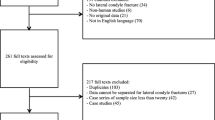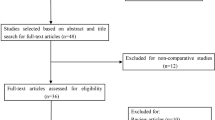Abstract
Introduction
Lateral condyle fractures in children have been typically been treated operatively using Kirschner wires (K wire) or cannulated screws (CCS); however, a definitive choice of implant remains a matter of debate. This systematic review aims to determine if union and functional outcomes of these fractures are better with screw fixation.
Methodology
A search of PubMed, Medline, Cochrane, and Google scholar was performed in March 2021. The results were screened by title and abstract, and relevance and a quality assessment of the data were performed for the articles meeting the inclusion criteria. Articles comparing radiological and functional outcomes of lateral condyle fractures treated with K wires or screws were included for examination. Articles were excluded if they did not compare outcomes of K wires and CCS together, or were in a language other than English, technical notes, case reports, and articles, which describe the use of fixation methods other than K wire or CCS as well as biomechanical studies were also excluded. Risk of bias and quality assessment of included articles were also done.
Results
Seven clinical studies were included. 44.4% (n = 4) were retrospective review of records with level III evidence (77.7%, n = 7). Only two included articles had good-quality assessment scores. Union was reported in 85.7% % in K wire group and 99.6% in CCS group. Functional outcomes were not statistically significant between the two groups.
Conclusion
Using screws to fix lateral condyle provides better union; however, there is no difference in the functional outcomes and complication rate between the two. Using screws or buried K wires adds the burden of an additional procedure for removal.



Similar content being viewed by others
Data availability statement
The data used by the authors for this manuscript is available on request from the corresponding author.
References
Beaty, J. R., & Sa, J. H. (2015). Lateral Condylar and Capitellar Fractures of the Distal Humerus. Rockwood and Wilkins’ Fractures in Children (8th ed., pp. 701–725). Philadelphia: Wolters Kluwer Health.
Eckhoff, M. D., Tadlock, J. C., Nicholson, T. C., Wells, M. E., Garcia, E. J., & Hennessey, T. A. (2022). Open reduction of pediatric lateral condyle fractures: a systematic review. Shoulder & Elbow, 14(3), 316–324. https://doi.org/10.1177/17585732211010299
Ganeshalingam, R., Donnan, A., Evans, O., Hoq, M., Camp, M., & Donnan, L. (2018). Lateral condylar fractures of the humerus in children: does the type of fixation matter? Bone Joint J., 100(3), 387–395.
Stein, B. E., Ramji, A. F., Hassanzadeh, H., Wohlgemut, J. M., Ain, M. C., & Sponseller, P. D. (2017). Cannulated lag screw fixation of displaced lateral humeral condyle fractures is associated with lower rates of open reduction and infection than pin fixation. Journal of Pediatric Orthopaedics., 37(1), 7–13. https://doi.org/10.1097/BPO.0000000000000579
Franks, D., Shatrov, J., Symes, M., Little, D., & Cheng, T. (2018). Cannulated screw versus Kirschner-wire fixation for Milch II lateral condyle fractures in a paediatric sawbone model: a biomechanical comparison. Journal of Children’s Orthopaedics, 12(1), 29–35. https://doi.org/10.1302/1863-2548.12.170090
Schlitz, R. S., Schwertz, J. M., Eberhardt, A. W., & Gilbert, S. R. (2015). Biomechanical analysis of screws versus K-wires for lateral humeral condyle fractures. Journal of Pediatric Orthopaedics., 35(8), e93–e97. https://doi.org/10.1097/BPO.0000000000000450
Gilbert, S. R., MacLennan, P. A., Schlitz, R. S., & Estes, A. R. (2016). Screw versus pin fixation with open reduction of pediatric lateral condyle fractures. Journal of Pediatric Orthopaedics B., 25(2), 148–152. https://doi.org/10.1097/BPB.0000000000000238
Page, M. J., McKenzie, J. E., Bossuyt, P. M., Boutron, I., Hoffmann, T. C., Mulrow, C. D., et al. (2021). The PRISMA 2020 statement: an updated guideline for reporting systematic reviews. Systematic reviews., 10(1), 1–11.
The Newcastle-Ottawa Scale (NOS) for assessing the quality of nonrandomised studies in meta-analyses. (2020). [Available from: https://www.ncbi.nlm.nih.gov/books/NBK115843/bin/appe-fm3.pdf.
Afaque SF, Singh A. Outcome of Cancellous screw vs K wire fixation for management of neglected lateral condyle fracture of humerus in children. Doi: https://doi.org/10.33545/orthor.2020.v4.i4a.240
Li, W. C., & Xu, R. J. (2012). Comparison of Kirschner wires and AO cannulated screw internal fixation for displaced lateral humeral condyle fracture in children. International Orthopaedics, 36(6), 1261–1266. https://doi.org/10.1007/s00264-011-1452-y
Singh, R., Garg, L., Jaiman, A., Sharma, V., & Talwar, J. (2015). Comparison of kirschner wires and cannulated screw internal fixation for displaced lateral humeral condyle fracture in skeletally immature patients. Journal of Clinical Orthopaedics & Trauma., 6(1), 62. https://doi.org/10.1016/j.jcot.2015.01.021
Thapa, P., Sapkota, K., Wahegaonkar, K., Ranjeet, N., Onta, P. R., & Thapa, U. J. (2019). Comparison of Kirschner wires and Cannulated screw internal fixation for displaced lateral humeral condyle fracture in children. Asian Journal of Medical Sciences., 10(6), 75–79. https://doi.org/10.3126/ajms.v10i6.25727
Wendling-Keim, D. S., Teschemacher, S., Dietz, H.-G., & Lehner, M. (2021). Lateral condyle fracture of the humerus in children: kirschner wire or screw fixation? European Journal of Pediatric Surgery, 31(04), 374–379. https://doi.org/10.1055/s-0040-1714656
Pennock, A. T., Salgueiro, L., Upasani, V. V., Bastrom, T. P., Newton, P. O., & Yaszay, B. (2016). Closed reduction and percutaneous pinning versus open reduction and internal fixation for type II lateral condyle humerus fractures in children displaced> 2 mm. Journal of Pediatric Orthopaedics., 36(8), 780–786. https://doi.org/10.1097/BPO.0000000000000570
Funding
This research did not receive any specific grant from funding agencies in the public, commercial, or not-for-profit sectors.
Author information
Authors and Affiliations
Contributions
Conceptualization: SM, SS, AK, JJ, SK. Methodology: SM, SS, AK, JJ, OAQ, SK. Software: not applicable. Validation: SM, JJ, OAQ, SK. Formal analysis: SS, AK, SM. Investigation: SS, AK. Resources: SS, AK, SM. Data Curation: SS, AK, SM. Writing: SM, SS, AK, JJ, OAQ, SK. Writing—Review & Editing: SM, SS, AK. Preparation, creation and/or presentation of the published work by those from the original research group, specifically critical review, commentary or revision – including pre-or post-publication stages: SM, SS, AK. Visualization: SM, SS, AK. Project administration: SM, JJ, OAQ, SK. Funding acquisition: Not applicable.
Corresponding author
Ethics declarations
Conflict of Interest
The authors declare that they have no conflict of interest.
Ethical Standard
This article does not contain any studies with human or animal subjects performed by the any of the authors.
Informed Consent
Not applicable to the study.
Additional information
Publisher's Note
Springer Nature remains neutral with regard to jurisdictional claims in published maps and institutional affiliations.
Rights and permissions
Springer Nature or its licensor (e.g. a society or other partner) holds exclusive rights to this article under a publishing agreement with the author(s) or other rightsholder(s); author self-archiving of the accepted manuscript version of this article is solely governed by the terms of such publishing agreement and applicable law.
About this article
Cite this article
Sinha, S., Kumar, A., Meena, S. et al. K Wires or Cannulated Screws for Fixation of Lateral Condyle Fractures in Children: A Systematic Review of Comparative Studies. JOIO 57, 789–799 (2023). https://doi.org/10.1007/s43465-023-00873-y
Received:
Accepted:
Published:
Issue Date:
DOI: https://doi.org/10.1007/s43465-023-00873-y




